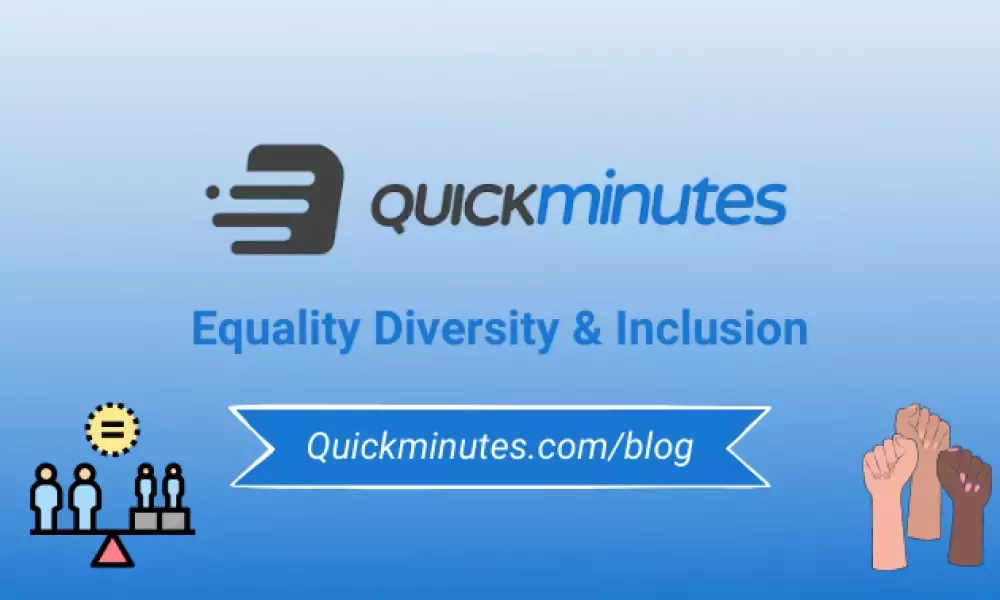
A Framework for solving Equality, Diversity and Inclusion
QuickMinutes EDI Dashboard
It seems almost daily now that there is a news story about how countries and organisations are striving towards creating a more inclusive society. The days of male-dominated business, public service, and indeed politics are in decline.
Often this topic is described as EDI (Equality, Diversity and Inclusion). Organizations incorporating an EDI-compliant framework aim to ensure fair treatment and opportunity for all by eradicating prejudice and discrimination on the basis of an individual or group of individual's protected characteristics.
Many of us will recall the recent ‘missing chair’ debacle involving the President of the European Commission, Ursula von der Leyen. It is worth noting well before this episode she has stated that “Gender equality is a core principle of the European Union, but it is not yet a reality. In business, politics and society as a whole, we can only reach our full potential if we use all of our talent and diversity. Using only half of the population, half of the ideas or half of the energy is not good enough. With the Gender Equality Strategy, we are pushing for more and faster progress to promote equality between men and women.”
Interestingly, the European Institute for Gender Equality (EIGE) has produced a Gender Equality Index (https://eige.europa.eu/gender-equality-index/2020/country) which highlights equality and representation for women across a range of leading domains including work, money, power and health.
Some of the statistics are hard to ignore. Even though more women graduate from University they earn 16% less than men. The level of Board representation for women is only 20% in the US. And these numbers only address male and female representation. People also discriminate based on race, ethnicity, religion, age, sexual orientation, gender identity, disability, and health, among others factors, and the intersection of two or more of any of these factors amplifies the experience. How can we ever expect to produce a more equal society if decision making in business is so skewed to one group alone?
To try to make progress towards balancing this situation though, we need to understand what is happening within the workplace. While these high-level statistics give us an indication, in many ways they are simply telling us what we already know.
The questions to ask now are, “How does this play out within your workplace?”
Could your organisation produce statistics to highlight your own EDI Index? What other groups can be better represented? Who is being marginalized that has special talent, skills, and ideas to offer?
The good news is, there are solutions out there that help us get towards the answer.
One of the core ways to track both diversity and influence within an organisation is through the medium within which decisions are made. Meetings!
Simply put, what happens within meetings is the pulse of your organisation. If one dominant voice alone remains constant within this medium then don’t expect to see a representative change.
Recently an Irish software company, Quickminutes.com, produced a mechanism with which to gather, track, and visualise this representation across your organisation through survey data collection resulting in a Equality Diversity and Inclusion Dashboard. QuickMinutes, through a GDPR compliant integration with your organisation’s HR system can present to you in real time the following;
1. A breakdown of representation (gender, ethnicity, etc) by group and an organisation level that can be compared with the previous month or year to track progress.
Group Gender Breakdown
Group Gender Breakdown at an Organisation Level
2. A pseudomonas breakdown of speaking time at meetings to ensure balanced and inclusive meetings leverages the diversity within decision making fora
3. Suggest Agenda templates / techniques that build inclusivity into the structure of meetings.
As a call to action, the first step should be to at least know where you are today as you embark on becoming more EDI compliant. Building an EDI framework within your organisation is going to be a lot easier when the very fabric of decision making is central to the process. Enjoy your next meeting.
QuickMinutes recognises that corporate policy is influenced by individuals & groups of individuals in strategic decision making fora within an organisation, and while it’s important to ensure their balanced representation around the table it is just as important that their contributions are sought and valued. To find out how QuickMinutes can improve your organization's EDI index you can book a meeting with us here.
QuickMinutes Updates